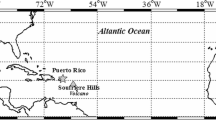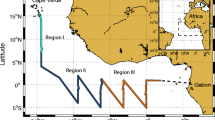Abstract
Four different samples of aerosol particles over the North Atlantic, South Atlantic, an area near the equator influenced by Saharan mineral dust, and the Antarctic Ocean were collected on board of the German research vessel “Polarstern” by a six stage cascade impactor system. A continental sample, typical in its size distribution pattern and heavy metal enrichment factors (relative to crust material) for industrialized areas, was used for comparison. To analyse the elements of interest, isotope dilution mass spectrometry (IDMS) using the thermal ionization technique was applied. The samples were digested with nitric acid followed by an electrodeposition of the heavy metals to be analysed in alkaline solution. Source identification could be carried out by the distribution of the heavy metals and enrichment factors on the different impactor stages using iron as a reference element for crustal origin. Two opposite types of size distribution patterns were obtained over the Atlantic Ocean. On the one hand, the main heavy metal fraction was found to be associated with the smallest particles collected on the last two impactor stages and the back-up filter with aerodynamic diameters (AD) of less than 0.95 μm. This pattern together with the high enrichment factors of up to several thousand indicates combustion processes and biogenic emissions as possible sources and were typical for cadmium and lead. On the other hand, chromium and iron were preferably associated with the larger particles of >1.5 μm AD. This and the low chromium enrichment factor demonstrate that the earth crust is the major source for these two elements in marine aerosol particles. Thallium and nickel could not be classified by one of these two size distribution patterns, which indicates that at least two different primary sources contribute to the content of these heavy metals in marine aerosol particles depending on the region investigated. Contrary to that, the sample collected over the Antarctic Ocean showed some significant differences. Here, a substantial amount of the total cadmium and lead was associated with the larger particles. However, relatively high enrichment factors found for cadmium, nickel, lead, and thallium in the smallest particles suggest a natural source, probably biogenic activities, in the Antarctic Ocean.
Similar content being viewed by others
References
Pui DYH, Liu BYH (1988) Physica Scripta 37:252
Davidson CI, Osborn JF (1986) In: Nriagu JO, Davidson CI (eds) Toxic metals in the atmosphere. Wiley, New York, p 355
Willeke K, Whitby KT (1975) J Air Pollut Control Assoc 25:529
Schroeder WH, Dobson M, Kane DM, Johnson ND (1987) J Air Pollut Control Assoc 37:1267
Buerki PR, Gaelli BC, Nyffeler UP (1989) Atmos Environ 23:1659
Marple VA, Chien CM (1980) Environ Sci Technol 14:976
Novick VJ, Alvarez JL (1987) Aeros Sci Technol 6:63
Chen BT, Yeh HC (1987) J Aerosol Sci 18:203
Marple VA, Liu BYH (1974) Environ Sci Technol 8:648
Newton GJ, Raabe OG, Mokler BV (1977) J Aerosol Sci 8:339
Wagner H, Georgii HW (1984) Staub-Reinhalt Luft 44:522
Dzubay TG, Hines LE, Stevens RK (1976) Atmos Environ 10:229
Markowski GR (1987) Aerosol Sci Technol 7:143
Marple VA, Rubow KL (1983) Am Ind Hyg Assoc J 44:361
Mitchell JP, Costa PA, Waters S (1988) J Aerosol Sci 19:213
Vaughan NP (1989) J Aerosol Sci 20:67
Gladney ES, Zoller WH, Jones AG, Gordon GE (1974) Environ Sci Technol 8:551
Maenhaut W, Zoller WH, Duce RA, Hoffmann GL (1970) J Geophys Res 84C:2421
Cunningham WC, Zoller WH (1981) J Aerosol Sci 12:367
Schütz L, Rahn KA (1982) Atmos Environ 16:171
Weisel CP, Duce RA, Fasching JL, Heaton RW (1984) J Geophys Res 89D: 11607
Heintzenberg J, Covert DS (1987) Tellus 39B:374
Völkening J, Baumann H, Heumann KG (1988) Atmos Environ 22:1169
Völkening J, Heumann KG (1990) J Geophys Res 95D:20623
Rädlein N, Heumann KG (1992) Int J Environ Anal Chem 48:127
Lewis CW, Macias ES (1980) Atmos Environ 14:185
Sturges WT, Harrison RM (1989) Atmos Environ 23:1083
Maenhaut W, Raemdonck H, Andreae MO (1987) Nucl Instr Methods Phys Res B22:248
Wouters L, Artaxo P, van Grieken R (1990) Int J Environ Anal Chem 38:427
Maenhaut W (1989) In: Pacyna JM, Ottar B (eds) Control and fate of atmospheric trace metals. Kluwer, Dordrecht, p 259
Völkening J, Heumann KG (1988) Fresenius Z Anal Chem 331:174
Lum KR, Betteridge JS, Macdonald RR (1982) Environ Technol Lett 3:57
Chester R, Murphy KJT, Towner J, Thomas A (1986) Chem Geol 54:1
Hamelin B, Grousset FE, Biscaye PE, Zindler A, Prospero JM (1989) J Geophys Res 94C:16243
Chester R, Lin FJ, Murphy KJT (1989) Environ Technol Lett 10:887
Heumann KG (1986) Fresenius Z Anal Chem 325:661
Heumann KG (1988) In: Adams F, Gijbels R, van Grieken R (eds) Inorganic mass spectrometry. Wiley, New York, p 301
Heumann KG (1990) In: Günzler H, Borsdorf R, Fresenius W, Huber W, Kelker H, Lüderwald I, Tölg G, Wisser H (eds) Analytiker Taschenbuch, Vol 9. Springer, Berlin Heidelberg New York, p 191
Barnes IL, Murphy TJ, Gramlich JW, Shields WR (1973) Anal Chem 45:1881
Völkening J, Heumann KG (1986) In: Todd FJF (ed) Advances in mass spectrometry 1985, Part B. Wiley, New York, p 1059
Rahn KA, Schütz L, Jaenicke R (1977) WMO [Publ.] 460 (Air pollut Meas Tech) Part II: 150
Taylor SR (1964) Geochim Cosmochim Acta 28:1273
Mason RP, Fitzgerald WF (1990) Nature 347:457
Author information
Authors and Affiliations
Additional information
Dedicated to Professor Dr. Dr. h.c. mult. J.F.K. Huber on the occasion of his 70th birthday
Rights and permissions
About this article
Cite this article
Rädlein, N., Heumann, K.G. Size fractionated impactor sampling of aerosol particles over the Atlantic Ocean from Europe to Antarctica as a methodology for source identification of Cd, Pb, Tl, Ni, Cr, and Fe. Fresenius J Anal Chem 352, 748–755 (1995). https://doi.org/10.1007/BF00323059
Received:
Revised:
Accepted:
Issue Date:
DOI: https://doi.org/10.1007/BF00323059




